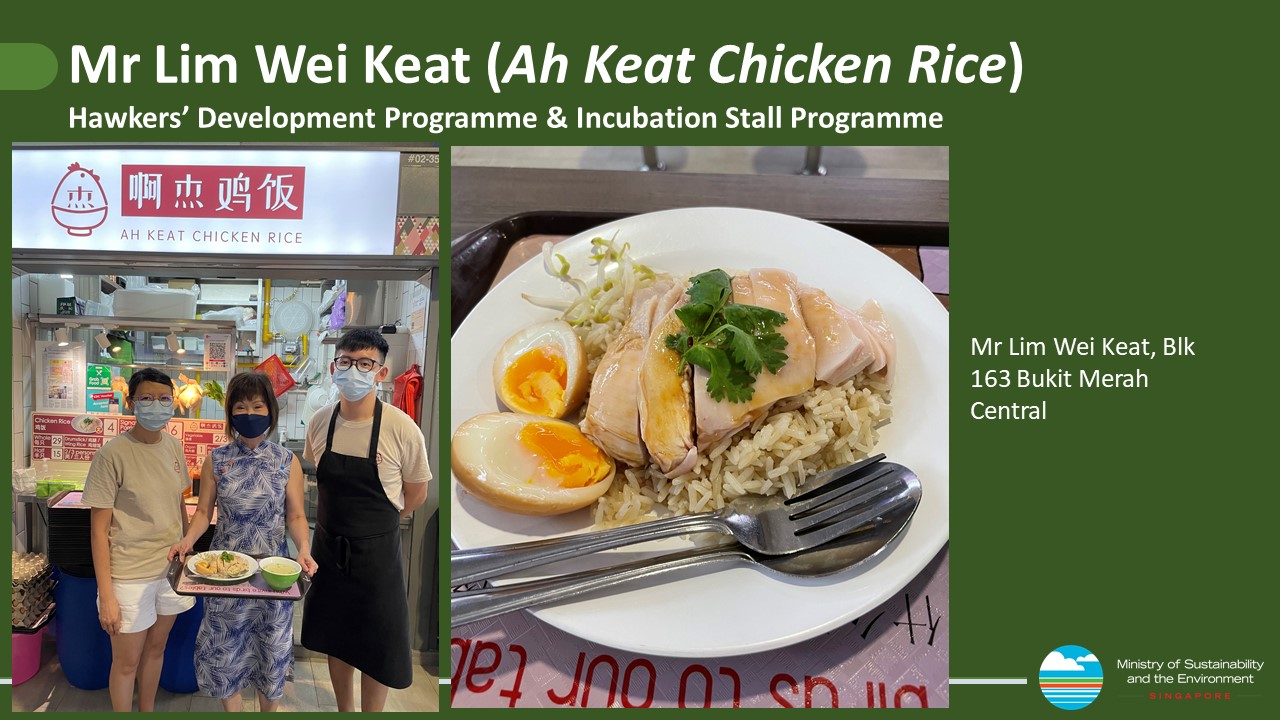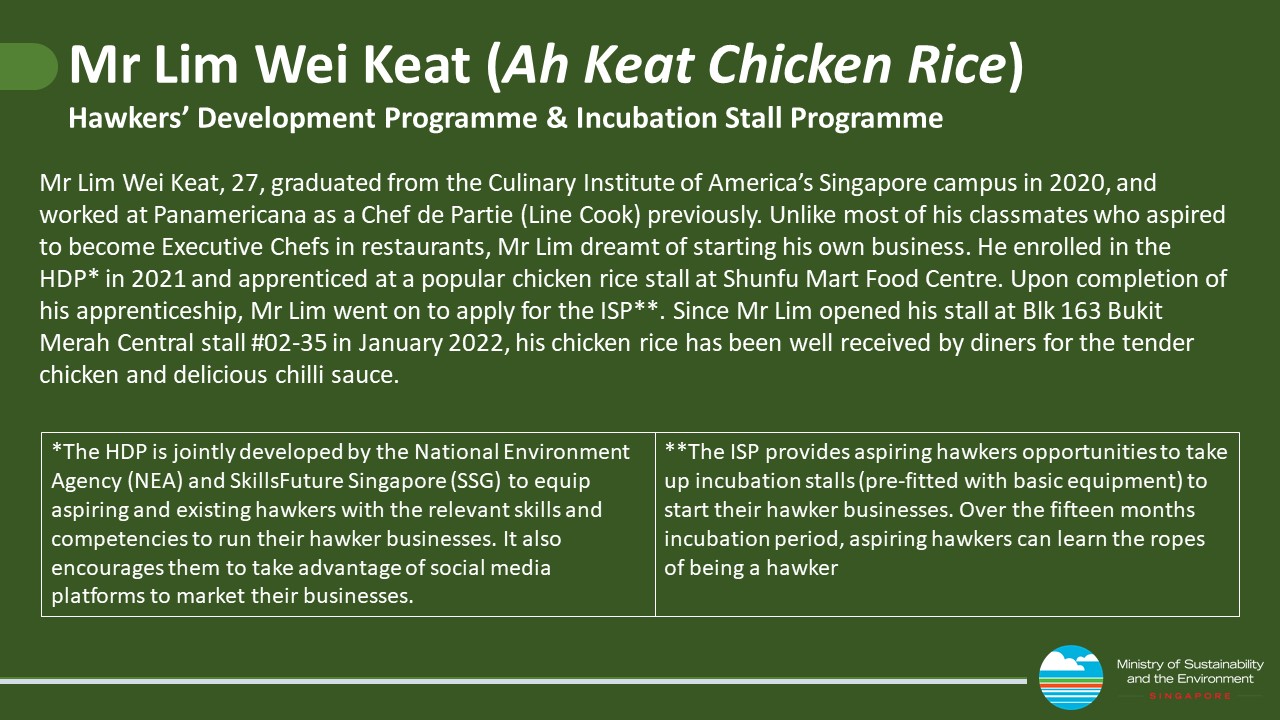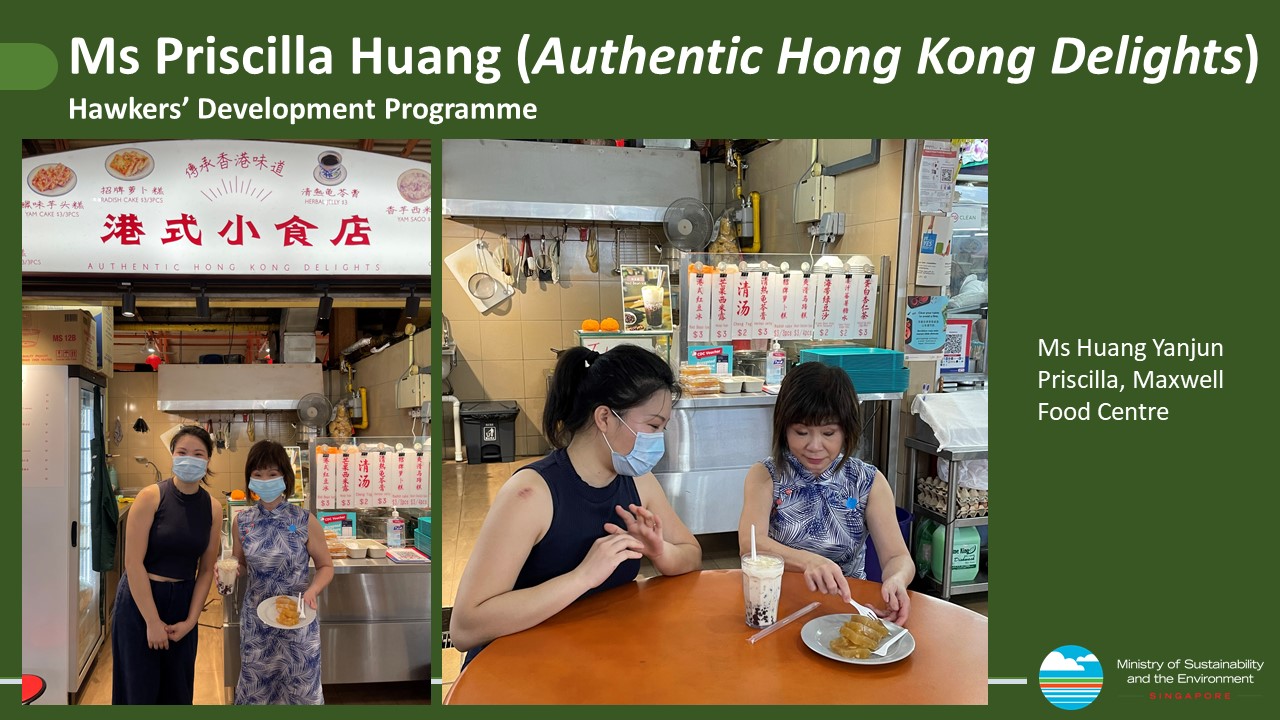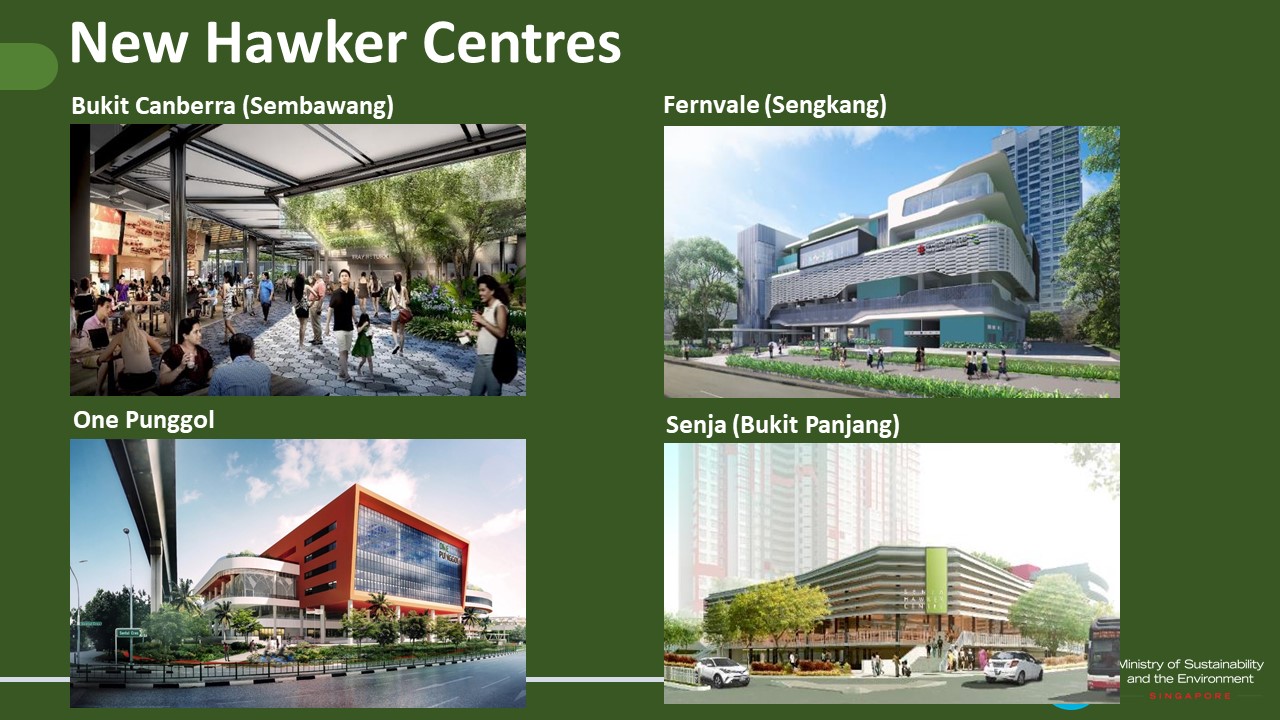Speech by Dr Amy Khor, Senior Minister of State for Sustainability and the Environment - Building An SG Clean Singapore, And Safeguard Our Hawker Culture
SPEECH BY DR AMY KHOR, SENIOR MINISTER OF STATE FOR SUSTAINABILITY AND THE ENVIRONMENT, MSE COS DEBATES, 7 MAR 2022
Building An SG Clean Singapore, And Safeguard Our Hawker Culture
INTRODUCTION
1 COVID-19 has reinforced the importance of good personal hygiene and clean public spaces. These have always been our priorities, and will better prepare us beyond COVID for Disease X, which is not a matter of “if” but “when”.
2 Over the past two years, we have improved the cleanliness of public spaces – from working with premises managers to uphold high cleanliness standards, to ensuring individuals practise personal responsibility by returning trays and binning litter.
3 Ms Nadia Ahmad Samdin would be pleased to know that since the Clean Tables Campaign and mandatory clean tables regime were implemented, the national average Tray and Crockery Return Rate (TCRR) in hawker centres has improved significantly, from 33% to 85%.
4 We have also achieved a national average TCRR of above 85% in coffeeshops and food courts. Many have shared that the dining environment is now cleaner, with faster turnover of tables and fewer incidences of pests and bird nuisance.
STRENGTHENING OUR PUBLIC HEALTH MEASURES
Working with Premises Managers to Raise Cleanliness Standards
5 We will build on this progress to ensure a clean and safe Singapore.
6 We commenced the progressive roll-out of the Environmental Sanitation (ES) Regime last July, which specifies mandatory baseline ES standards for high-risk premises and places greater accountability on premises managers to meet these standards.
7 We introduced the ES regime in more than 3,000 premises under the inaugural phase, including preschools, MOE schools, food centres, markets and coffeeshops, and the first tranche of eldercare, youth and social service facilities.
8 Together with the sector leads, we developed sector-specific ES standards, and trained more than 3,600 Environmental Control Coordinators (ECCs). The ECCs will assist premises managers to develop and oversee the implementation of an ES programme, which specifies cleaning frequencies and disinfection protocols. To Ms Hany Soh’s query, the regime was rolled out to preschools in November 2021 and all have appointed personnel to be ECCs.
9 The ES regime ensures that premises are properly cleaned and disinfected regularly. For example, from March this year, coffeeshops are required to carry out thorough cleaning every quarter on top of routine cleaning. This is a marked difference from just ad-hoc cleaning before. High-touch surfaces would also be cleaned and disinfected more frequently.
10 Premises managers are also sensitised to their responsibility to prevent outbreaks of infectious diseases like gastroenteritis within their premises. For instance, preschools have found the regime useful in providing clear guidance on minimum cleaning and disinfection frequencies, and scope of cleaning and disinfection works, neither of which were clearly defined before.
11 Ms Soh would be glad to hear that we will implement the regime at another 2,700 premises this year. These would include publicly accessible premises with high footfall such as large shopping malls, as well as private education institutions.
12 We have worked with these sectors to develop sector-specific ES standards. All premises will minimally require an ECC. For large premises with multiple tenants like shopping malls, Environmental Control Officers (Specified Premises) will be introduced to oversee more wide-ranging public health issues and management of stakeholders. We aim to train 2,700 more ECCs and ECO(SP)s this year.
Extending Smoking Prohibition to Protect Singaporeans from Second-hand Tobacco Smoke
13 Another important aspect of a clean and safe environment is protecting Singaporeans against the harmful effects of second-hand tobacco smoke.
14 Today, smoking is prohibited in more than 49,000 premises, including covered walkways and common areas of residential buildings. We have prioritised places where second-hand tobacco smoke affects more people, such as community spaces.
15 Ms Cheryl Chan, Dr Lim Wee Kiak, Mr Louis Ng and Ms Poh Li San would be glad to hear that, together with PUB, NParks and the Sentosa Development Corporation, NEA will extend the smoking prohibition to more places including all remaining public parks and gardens, Active, Beautiful, Clean (ABC) Waters Sites, and 10 beaches from 1 July 2022.
16 In addition to neighbourhood parks in public and private housing estates where smoking is already prohibited, smoking will be prohibited at Regional and City Parks like East Coast Park and Fort Canning Park, and all Park Connectors. Smoking will also be prohibited at 10 recreational beaches, including 3 beaches in Sentosa.
17 With this extension, Singaporeans can enjoy these shared recreational sites without exposure to second-hand tobacco smoke. There will be a 3-month advisory period before enforcement commences on 1 October 2022.
18 We currently have no plans to set up additional No Smoking Zones. We will review the need for further extensions of the smoking prohibition from time to time. Setting up No Smoking Zones requires significant stakeholder buy-in and operational resources to implement. We will need to plan extensively, assess the suitability of the precinct and availability of sites for designated smoking areas.
19 On smoking in homes, which Dr Lim, Ms Poh and Mr Gan Thiam Poh asked about, legislation is no panacea to curbing second-hand tobacco smoke in homes. There are privacy concerns and technological limitations to gathering evidence required for enforcement.
20 The Designated Smoking Points in Nee Soon South have thus far not resulted in a sustained reduction in feedback received on smoking in homes in the division since its implementation. Nevertheless, we will continue to monitor the effectiveness of DSPs as localised solutions, even as we work with MOH and HPB to discourage smoking at home.
21 On end-game laws for smoking, MOH remains open and will study how New Zealand implements the ban, its effectiveness and how their experience could be applicable to Singapore.
Supporting our Transition to an Endemic COVID-19 Environment
22 Besides adopting preventive measures to minimise the spread of infectious diseases, we are building up capabilities to deal with public health threats.
23 Singapore is an early adopter of wastewater surveillance for COVID-19, which is being explored in various countries. In response to Mr Gan’s question, when transmission first occurred at workers’ dormitories, NEA brought in wastewater testing to assess the situation, including the viral loads collected from each dormitory. Our findings were used to complement individual testing, guide infection control measures and facilitate the progressive clearance of dormitories by the Inter-Agency Task Force.
24 Monitoring has since been expanded to student hostels, nursing homes, and residential sites. From a modest 8 sites in May 2020, we gradually expanded surveillance coverage to 200 sites in July 2021.
25 Since February 2022, we have achieved surveillance coverage of 440 sites, including 150 sites distributed across residential areas and town centres. We have also expanded our laboratory testing capacity to 4,000 samples being tested per week, up from 2,500 in July last year.
26 As Singapore transits to COVID-endemicity, the focus of wastewater testing has shifted from early case detection to providing situational awareness. The data collected alerts government agencies and premises owners or operators of the situation, which allows them to calibrate public health measures.
27 It provides objective information on whether infections among the population are increasing or decreasing, independent of the population’s health seeking behaviour and prevailing clinical test protocols. This will therefore be an important surveillance tool even as we transit to an endemic state.
28 Further research and development will allow the wastewater surveillance system to be used for monitoring other infectious disease threats in the future.
Raising Cleanliness Standards at Public Toilets
29 Mr Gan asked about improvements to toilets. We launched the Toilet Improvement Programme in October 2020 to raise the cleanliness of toilets in hawker centres and coffeeshops.
30 The programme supported premises in improving toilet design and choice of sanitary fittings for easier cleaning, and coffeeshop operators’ initial adoption of fortnightly deep cleaning, on top of daily cleaning. NEA has received applications from 62 eligible coffeeshops and 28 hawker centres. 24 coffeeshops and one hawker centre have completed toilet enhancement works.
SAFEGUARDING OUR HAWKER CULTURE
Supporting Our Hawkers Throughout the Pandemic
31 I will now speak about our hawker culture, my favourite topic! Our hawkers are frontline heroes, providing us affordable hawker food during this pandemic. NEA has provided relief measures to hawkers over the last two years, including 10 months’ rental waivers and 6 months’ subsidies for table-cleaning and centralised dishwashing services.
32 Eligible hawkers also received up to $9,000 via the Self-employed Person Income Relief Scheme (SIRS) in 2020, and a one-off cash payout of $500 under the Market and Hawker Centre Relief Fund (MHCRF) last year.
33 We will continue to support our hawkers. Minister for Finance announced that small F&B businesses, one of the sectors most affected by COVID-19, will receive the Small Business Recovery Grant.
34 SFA-licensed operators and stallholders in markets, hawker centres, coffeeshops, food courts and canteens will receive this grant. They will receive $1,000 for each local employee receiving mandatory CPF contributions, capped at $10,000. Those without local employees will receive a flat $1,000 if they are Singapore Citizens or Permanent Residents.
35 Our efforts have helped hawkers during these tough times. On average, 17 cooked food stallholders or 0.3% terminated their leases each month between 2020 and 2021. This is lower than the monthly average of 28 terminations between 2017 to 2019.
36 Ms Joan Pereira asked if more can be done to help hawkers reduce ingredient cost. We will review her suggestion of bulk purchasing carefully and also consider the interest from our hawkers, where many may already have established relationships and specific arrangements with their suppliers for their preferred ingredients.
37 To prepare hawkers for the digital economy and expand their reach to potential patrons, hawkers, community groups, food delivery platforms, together with NEA and IMDA came together to form the SGTogether Alliance for Action (AfA) for Online Ordering for Hawkers last June and developed pilot initiatives to help hawkers utilise online services.
38 About 1 in every 4 cooked food stallholders have been supported via NEA’s Food Delivery Support Scheme. Currently, about half of our 6,000 plus cooked food stallholders are on board these services, and almost 70% of them have adopted e-payment.
39 WhyQ, Deliveroo, FoodPanda and Grab have stepped up to pilot a Common Acquirer Model for online food delivery in 15 hawker centres at zero commission to hawkers. Hawkers can receive online orders from any of these platforms through a single ordering device. Alternatively, they can choose to transact offline through WhyQ hawker captains.
40 To date, 18 hawker centres have set up Digital Support for Hawkers groups, which provide peer support to help less digitally savvy hawkers embrace digital opportunities. This includes creating Facebook pages for each centre, facilitating online community group buys, and organising bulk meal orders.
41 I am pleased to share that many of my fellow Members of Parliament have adopted AfA’s recommendations on group buys from hawkers for our lunches during Parliament sittings! For today’s lunch, many of us enjoyed wanton noodles, chicken rice and burgers from Commonwealth Crescent, Bukit Merah and Golden Mile! More enticing and mouth-watering hawker dishes to come!
Futureproofing Our Hawker Centres
42 Ms Nadia asked for an update on the Hawker Centres Transformation Programme (HTP). Last year, I shared plans about the HTP to future-proof hawker centre infrastructure. While HTP will be applied to new and redeveloped centres, we are also piloting it at two existing centres even as they face constraints with limited floor space.
43 I am pleased to announce that we will consult stakeholders, including Hawkers’ Associations, Town Councils and Advisers in 2022 to jointly develop the HTP pilot at Geylang Serai Market and Cheng San Market and Food Centre.
44 The proposed scope of works may include High-Volume Low-Speed fans to improve ventilation, provisions to support flexible implementation of Safe Management Measures, such as quick deployment and removal of temporary access control, reconfiguration of tables and chairs to reduce crowding, and additional handwashing facilities to raise hygiene levels.
Sustaining the Hawker Trade
45 Finally, our hawker culture would not exist without our hawkers.
46 On Mr Don Wee’s query, there has been healthy demand for hawker stalls, with high occupancy rates averaging consistently at about 97% at existing and new hawker centres. NEA has also been receiving enquiries from individuals who are keen to take up stalls at the new centres, and the monthly tender for vacant stalls at existing centres have continued to attract a good number of bids.
47 Ms Pereira asked about efforts to attract new hawkers, including improving job prospects and working conditions. Our hawkers today are mostly self-employed individuals, with the flexibility and autonomy to decide their operating hours based on what they sell. They are covered by Medishield Life and can also top up their medical insurance individually, or even explore purchasing together as a group through their Hawkers’ Associations (HAs).
48 We have been helping our aspiring hawkers prepare for the trade, through the Incubation Stall Programme and Hawkers’ Development Programme, and similar programmes by Socially-conscious Enterprise Hawker Centre operators. Over 40 new hawkers have joined the trade through these programmes. Their median age is 33, significantly lower than the overall median age of hawkers of 60.
49 11 aspiring hawkers are currently operating incubation stalls, with another six awaiting allocation of incubation stalls.
50 Some of our new hawkers include Ms Priscilla Huang (aged 31) of Authentic Hong Kong Delights 1, and Mr Lim Wei Keat (aged 27) of Ah Keat Chicken Rice 2, who joined the hawker trade over the past year after completing HDP.
51 In addition to Wei Keat’s chicken rice which we had for lunch, I have ordered mochi and water chestnut cakes from Priscilla for Parliament’s tea break today. A few others like Ms Amber Pong (aged 32) of The Headless Baker at Ghim Moh Market, who converted to a full-fledged hawker after completing her Incubation Stall Programme, even opened a second outlet in July last year .
52 To ensure that veteran hawkers’ recipes and skills are not lost, the Hawkers Succession Scheme (HSS), which was shared** last year, will link retiring hawkers without succession plans but wish to pass on their businesses, skills and recipes, with aspiring hawkers.
53 To Ms Pereira and Mr Raj Joshua Thomas’s question about the HSS, a 10-member independent advisory panel has been set up to work with NEA to support and review the HSS pilot. Among the 10 panellists, 6 are established hawkers. The rest include culinary chefs, hawker centre operators and culinary training partners.
54 The panellists will help identify suitable veteran hawkers, assess aspiring successors’ readiness, and provide feedback to improve the programme.
55 Under the pilot, aspiring hawkers will be assessed on culinary skills and capacity to learn, before pairing up with veteran hawkers. They will undergo a three-month apprenticeship under the veteran hawkers. Aspiring successors will be evaluated on their ability to execute the veterans’ signature dishes. Where needed, veteran hawkers may continue to mentor the successor for two additional months. In recognition of their time and effort spent, veteran hawkers will receive a nominal stipend of up to $5,500.
56 This is but a token of appreciation and is not a measure of the effort that veterans have invested into establishing their clientele and refining their recipes. The HSS is not intended to be a commercial arrangement but is an option to help retiring veteran hawkers find suitable successors and preserve their culinary legacy for future patrons.
57 We will also introduce safeguards to protect the interest of the veteran hawkers such as requiring successors to serve the veteran hawkers’ signature dishes and retain the stall names for three years.
New Hawker Centres to Serve Residents’ Needs
58 Mr Gan and Mr Wee asked about the construction progress of new hawker centres.
59 While COVID-19 has caused some delay, four new centres3 – namely Bukit Canberra, Fernvale, One Punggol and Senja Hawker Centres, will begin operations by 3rd quarter this year. In addition, five more centres in the construction stage will progressively be completed in the next few years, and two more are in the planning and design stage.
60 Residents in Tampines Town can also look forward to another new hawker centre. More details of this new centre will be shared in due course.
61 Ms Nadia will be glad to hear that upcoming centres will incorporate sustainability features. All new centres will have food waste digesters. Some will also have solar panels.
62 Two redeveloped centres will also be starting operations this year. Market Street Hawker Centre that used to be at Golden Shoe Carpark will open for business from 1 April, at levels 2 and 3 of the integrated development CapitaSpring on Market Street, and continue to provide affordable food options for those working in the CBD.
63 We also expect Margaret Drive Hawker Centre, which replaces the hawker centre at Block 1A, 2A, 3A Commonwealth Drive, to commence operations from 4Q 2022.
64 Chairman, in Mandarin please.
65 国家环境局将进一步扩大禁烟令范围。从7月1日起,我们将禁止民众在如东海岸公园、福康宁公园等区域和市区公园以及连接各个公园的公园连道上吸烟。禁烟令范围也将包括 “活跃、美丽、清洁” 水源计划下的休闲设施,以及包括圣淘沙岛上3个沙滩在内的10个休闲海滩。
66 在过去的两年里,政府通过各种方式援助、支持我们的小贩。 这包括免去总共10个月的租金以及补贴6个月的座位清洁和中央碗盘清洗费用。符合条件的摊贩也在2020年收到高达9,000元的收入补贴,并在去年也收到500元的现金补助。
67 以继续支持摊贩们,我们将通过刚宣布的小商家复苏津贴计划提供所有持有食品局执照的巴刹、小贩中心、咖啡店、食阁和食堂的业者和摊主一次性的现金补贴。
68 业者和摊主每雇用一名有缴交公积金的员工,可获得1,000元补贴,补贴顶限为一万元。没有雇用员工的业者和摊主也将获得1,000 元。
69 在过去4年里,我们也通过各种计划培训小贩新手。至今已有超过40名新手小贩加入小贩行列。我们会继续支持新手小贩,包括通过“小贩承前启后计划” 配对新手小贩与资深小贩促进手艺、食谱的传承。
70 此外,今年将会有四个新的小贩中心开始营业。它们分别在武吉班让、三巴旺、盛港和榜鹅,将为这些市镇的居民提供更多的饮食选择和便利。我们也将会在淡滨尼增建一个小贩中心。详情我们之后会再公布。
71 最后,马吉街熟食中心也将从4月1日起迁回原址,在新发展的综合项目CapitaSpring的2、3楼重新开业。所有原来在“金鞋”中心的摊贩也都会回到重新开业的马吉街熟食中心。
CONCLUSION
72 Chairman, despite the challenges of the pandemic, everyone – be it the cleaning industry, premises managers or hawkers – have demonstrated resilience, seized opportunities to improve cleanliness, and embrace new business opportunities online.
73 Let us continue to work together to build a truly SG Clean Singapore, and safeguard our hawker culture for future generations. Indeed, let’s support SG Hawkers!






